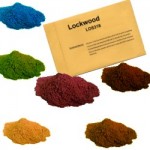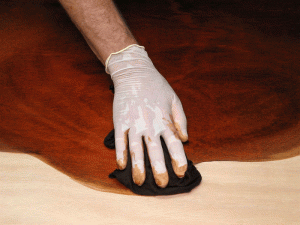Water Soluble Dye Stain
 Water-soluble dyes are sold in powder form. They were first developed for the textile industry, but later adapted for wood. They were one of the most common stains used in the furniture industry until the 1950s when metal-complex dyes were developed. But they still remain popular to the amateur and small-shop woodworkers because of their richness, wide choice of colors and ease of use. Also the dye has an infinite shelf life in both powder and liquid forms.
Water-soluble dyes are sold in powder form. They were first developed for the textile industry, but later adapted for wood. They were one of the most common stains used in the furniture industry until the 1950s when metal-complex dyes were developed. But they still remain popular to the amateur and small-shop woodworkers because of their richness, wide choice of colors and ease of use. Also the dye has an infinite shelf life in both powder and liquid forms.
To make a liquid dye from the powder, simply dissolve it in water. The ratio of one ounce of powder in one quart of water usually makes a standard color, but you can dissolve more or less powder to create a more or less intense color. The hotter the water the more powder you can dissolve. Use distilled water if there’s so much metal residue in your tap water that it affects the color.
Water-soluble dyes have two great advantages and one disadvantage when compared to  the other stains in this website.
the other stains in this website.
One advantage is that the dye doesn’t obscure the wood no matter how dark you get it. A black dye, for example, can ebonize wood without completely hiding the figure.
Also, because there’s no binder in the dye, you can darken or lighten or change the color right on the wood even after the dye has totally dried. Apply more dye to darken the color. Wipe with a wet or damp cloth to lighten the color. Apply a different colored dye to change the color.
The problem with dye is that it fades in UV light, which means sunlight and fluorescent light. You may not want to use a dye if your project will be subjected to one of these light sources.
Two related but more seldom used dyes are alcohol-soluble and oil-soluble powder dyes. Alcohol-soluble dyes are sometimes used by touch-up specialists in combination with shellac to take advantage of the fast drying characteristic, and oil-soluble dyes are sometimes added to oil stains.
 Choose a water-soluble dye if you want deeper or more even coloring than can be achieved with stains that contain a binder, or you want more control of the color after you apply the stain to the wood.
Choose a water-soluble dye if you want deeper or more even coloring than can be achieved with stains that contain a binder, or you want more control of the color after you apply the stain to the wood.
To apply this type of stain follow the steps below:
- Make sure wood surface is free from oil, grease, debris, or dust.
- With any water based product you have to be concerned with raising the grain. So before you stain, soak down the wood surface and allow to dry. Then sand with a 220 grit sandpaper and now you should be set to start staining.
- Take your premixed water soluble dye and apply it with a brush or lint free rag to the wood surface. Follow the direction of the grain.
- Give the stain at least five minutes before wiping the excess with a rag. Be careful not to use a damp rag, as this can thin out the dye stain and lighten the color of the wood.
- Once desired color is achieved, allow to dry for 24 hours before applying a finishing coat.